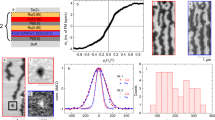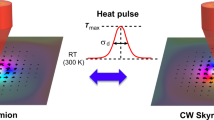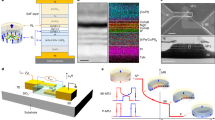Abstract
Magnetic skyrmions are topological spin textures that could be used to create magnetic memory and logic devices. Such devices typically rely on current-controlled motion of skyrmions, but using skyrmions that are fixed in space could lead to more compact and energy-efficient devices. Here we report the manipulation of fixed magnetic skyrmions using voltage-controlled magnetic anisotropy. We show that skyrmions can be stabilized in antiferromagnet/ferromagnet/oxide heterostructure films without any external magnetic field due to an exchange bias field. The isolated skyrmions are annihilated or formed by applying voltage pulses that increase or decrease the perpendicular magnetic anisotropy, respectively. We also show that skyrmions can be created from chiral domains by increasing the perpendicular magnetic anisotropy of the system. Our experimental findings are corroborated using micromagnetic simulations.
This is a preview of subscription content, access via your institution
Access options
Access Nature and 54 other Nature Portfolio journals
Get Nature+, our best-value online-access subscription
$29.99 / 30 days
cancel any time
Subscribe to this journal
Receive 12 digital issues and online access to articles
$119.00 per year
only $9.92 per issue
Buy this article
- Purchase on Springer Link
- Instant access to full article PDF
Prices may be subject to local taxes which are calculated during checkout





Similar content being viewed by others
Data availability
MFM data files used in this paper are available at https://doi.org/10.6084/m9.figshare.12234446. Other data that support the plots within this paper and other findings of this study are available from the corresponding authors upon reasonable request
References
Pfleiderer, C., Rosch, A., Neubauer, A. & Georgii, R. Skyrmion lattice in a chiral magnet. Science 323, 915–920 (2009).
Jonitez, F. et al. Spin transfer torques in MnSi at ultralow current densities. Science 330, 1648–1651 (2010).
Fert, A., Cros, V. & Sampaio, J. Skyrmions on the track. Nat. Nanotechnol. 8, 152–156 (2013).
Tomasello, R. et al. A strategy for the design of skyrmion racetrack memories. Sci. Rep. 4, 6784 (2014).
Mochizuki, M. et al. Thermally driven ratchet motion of a skyrmion microcrystal and topological magnon Hall effect. Nat. Mater. 13, 241–246 (2014).
Jiang, W. et al. Blowing magnetic skyrmion bubbles. Science 349, 283–286 (2015).
Yu, G. et al. Room-temperature skyrmion shift device for memory application. Nano Lett. 17, 261–268 (2017).
Yu, X. Z. et al. Near room-temperature formation of a skyrmion crystal in thin-films of the helimagnet FeGe. Nat. Mater. 10, 106–109 (2011).
Jiang, W. et al. Direct observation of the skyrmion Hall effect. Nat. Phys. 13, 162–169 (2017).
Boulle, O. et al. Room-temperature chiral magnetic skyrmions in ultrathin magnetic nanostructures. Nat. Nanotechnol. 11, 449–454 (2016).
Büttner, F. et al. Field-free deterministic ultrafast creation of magnetic skyrmions by spin–orbit torques. Nat. Nanotechnol. 12, 1040–1044 (2017).
Caretta, L. et al. Fast current-driven domain walls and small skyrmions in a compensated ferrimagnet. Nat. Nanotechnol. 13, 1154–1160 (2018).
Everschor-Sitte, K., Sitte, M., Valet, T., Abanov, A. & Sinova, J. Skyrmion production on demand by homogeneous DC currents. New J. Phys. 19, 092001 (2017).
Litzius, K. et al. Skyrmion Hall effect revealed by direct time-resolved X-ray microscopy. Nat. Phys. 13, 170–175 (2016).
Maccariello, D. et al. Electrical detection of single magnetic skyrmions in metallic multilayers at room temperature. Nat. Nanotechnol. 13, 233–237 (2018).
Moreau-Luchaire, C. et al. Additive interfacial chiral interaction in multilayers for stabilization of small individual skyrmions at room temperature. Nat. Nanotechnol. 11, 444–448 (2016).
Romming, N. et al. Writing and deleting single magnetic skyrmions. Science 341, 636–639 (2013).
Woo, S. et al. Observation of room-temperature magnetic skyrmions and their current-driven dynamics in ultrathin metallic ferromagnets. Nat. Mater. 15, 501–506 (2016).
Moriya, T. Anisotropic superexchange interaction and weak ferromagnetism. Phys. Rev. 120, 91–98 (1960).
Dzyaloshinsky, I. A thermodynamic theory of ‘weak’ ferromagnetism of antiferromagnetics. J. Phys. Chem. Solids 4, 241–255 (1958).
Shiota, Y. et al. Induction of coherent magnetization switching in a few atomic layers of FeCo using voltage pulses. Nat. Mater. 11, 39–43 (2012).
Amiri, P. K. & Wang, K. L. Voltage-controlled magnetic anisotropy in spintronic devices. Spin 2, 1240002 (2012).
Bhattacharya, D. & Atulasimha, J. Skyrmion-mediated voltage-controlled switching of ferromagnets for reliable and energy-efficient two-terminal memory. ACS Appl. Mater. Interfaces 10, 17455–17462 (2018).
Bhattacharya, D., Al-Rashid, M. & Atulasimha, J. Voltage controlled core reversal of fixed magnetic skyrmions without a magnetic field. Sci. Rep. 6, 31272 (2016).
Bhattacharya, D., Al-Rashid, M. M. & Atulasimha, J. Energy efficient and fast reversal of a fixed skyrmion two-terminal memory with spin current assisted by voltage controlled magnetic anisotropy. Nanotechnology 28, 425201 (2017).
Nakatani, Y., Hayashi, M., Kanai, S., Fukami, S. & Ohno, H. Electric field control of skyrmions in magnetic nanodisks. Appl. Phys. Lett. 108, 152403 (2016).
Kasai, S., Sugimoto, S., Nakatani, Y., Ishikawa, R. & Takahashi, Y. K. Voltage-controlled magnetic skyrmions in magnetic tunnel junctions. Appl. Phys. Express 12, 083001 (2019).
Hsu, P. J. et al. Electric-field-driven switching of individual magnetic skyrmions. Nat. Nanotechnol. 12, 123–126 (2017).
Schott, M. et al. The skyrmion switch: turning magnetic skyrmion bubbles on and off with an electric field. Nano Lett. 17, 3006–3012 (2017).
Ma, C. et al. Electric field-induced creation and directional motion of domain walls and skyrmion bubbles. Nano Lett. 19, 353–361 (2019).
Azam, M. A., Bhattacharya, D., Querlioz, D. & Atulasimha, J. Resonate and fire neuron with fixed magnetic skyrmions. J. Appl. Phys. 124, 152122 (2018).
Li, S. et al. Magnetic skyrmion-based artificial neuron device. Nanotechnology 28, 31LT01 (2017).
Chen, M.-C., Sengupta, A. & Roy, K. Magnetic skyrmion as a spintronic deep learning spiking neuron processor. IEEE Trans. Magn. 54, 1500207 (2018).
Song, K. M. et al. Skyrmion-based artificial synapses for neuromorphic computing. Nat. Electron. 3, 148–155 (2020).
Pinna, D. et al. Skyrmion gas manipulation for probabilistic computing. Phys. Rev. Appl. 9, 064018 (2018).
Garcia-Sanchez, F., Sampaio, J., Reyren, N., Cros, V. & Kim, J.-V. A skyrmion-based spin–torque nano-oscillator. New J. Phys. 18, 075011 (2016).
Zhang, S. et al. Current-induced magnetic skyrmions oscillator. New J. Phys. 17, 023061 (2015).
Yu, G. et al. Room-temperature skyrmions in an antiferromagnet-based heterostructure. Nano Lett. 18, 980–986 (2018).
Ma, X. et al. Dzyaloshinskii–Moriya interaction across an antiferromagnet–ferromagnet interface. Phys. Rev. Lett. 119, 027202 (2017).
Wu, D. et al. Spin–orbit torques in perpendicularly magnetized Ir22Mn78/Co20Fe60B20/MgO multilayer. Appl. Phys. Lett. 109, 222401 (2016).
Li, X. et al. Enhancement of voltage-controlled magnetic anisotropy through precise control of Mg insertion thickness at CoFeB|MgO interface. Appl. Phys. Lett. 110, 052401 (2017).
Liu, Y. et al. Chopping skyrmions from magnetic chiral domains with uniaxial stress in magnetic nanowire. Appl. Phys. Lett. 111, 022406 (2017).
Yang, H., Boulle, O., Cros, V., Fert, A. & Chshiev, M. Controlling Dzyaloshinskii–Moriya interaction via chirality dependent layer stacking, insulator capping and electric field. Sci. Rep. 8, 12356 (2018).
Vansteenkiste, A. et al. The design and verification of MuMax3. AIP Adv. 4, 107133 (2014).
Yamanouchi, M. et al. Domain structure in CoFeB thin films with perpendicular magnetic anisotropy. IEEE Magn. Lett. 2, 3000304 (2011).
Acknowledgements
D.B. and J.A. are supported in part by NSF CAREER grant CCF-1253370, NSF CCF-1909030 and NSF ECCS 1609303, a VCU Quest Commercialization Grant and a Virginia Microelectronics Seed Grant. S.A.R., H.W., B.D. and K.L.W. are supported by the National Science Foundation (NSF) ECCS 1611570 and NSF Nanosystems Engineering Research Center for Translational Applications of Nanoscale Multiferroic Systems (TANMS). The authors at UCLA are also supported by Spins and Heat in Nanoscale Electronic Systems (SHINES), an Energy Frontier Research Center funded by the US Department of Energy (DOE), Office of Science, Basic Energy Sciences (BES) under award no. SC0012670. The authors at UCLA were also partially sponsored by the Army Research Office under grant no. W911NF-16-1-0472.
Author information
Authors and Affiliations
Contributions
D.B., S.A.R., H.W., K.L.W. and J.A. played a role in conceiving the idea, planning the experiments, discussing the data, analysing the results and writing the manuscript. D.B. performed the MFM and micromagnetic simulations. S.A.R. performed other experimental characterization, H.W. fabricated the samples and B.D. performed MOKE. J.A. coordinated the overall project.
Corresponding authors
Ethics declarations
Competing interests
The authors declare no competing interests.
Additional information
Publisher’s note Springer Nature remains neutral with regard to jurisdictional claims in published maps and institutional affiliations.
Supplementary information
Supplementary Information
Supplementary Sections 1–6.
Supplementary Video
Skyrmions and stripe domains observed in the intermediate steps of switching during a cycle of perpendicular magnetic field.
Rights and permissions
About this article
Cite this article
Bhattacharya, D., Razavi, S.A., Wu, H. et al. Creation and annihilation of non-volatile fixed magnetic skyrmions using voltage control of magnetic anisotropy. Nat Electron 3, 539–545 (2020). https://doi.org/10.1038/s41928-020-0432-x
Received:
Accepted:
Published:
Issue Date:
DOI: https://doi.org/10.1038/s41928-020-0432-x
This article is cited by
-
All-electrical skyrmionic magnetic tunnel junction
Nature (2024)
-
Anomalous hall and skyrmion topological hall resistivity in magnetic heterostructures for the neuromorphic computing applications
npj Spintronics (2024)
-
Progress on elliptical magnetic skyrmions
Rare Metals (2023)
-
Quantum control of spin qubits using nanomagnets
Communications Physics (2022)
-
Reversible writing/deleting of magnetic skyrmions through hydrogen adsorption/desorption
Nature Communications (2022)



